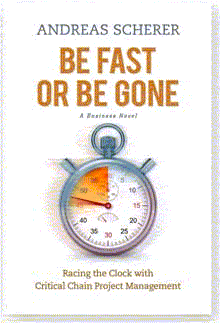 |
|
|
 |
|||
|
Using TOC To Improve Project Management. Most projects, whether big or small, are undertaken either to create a new structure, such as a plant, an airport, an Olympic stadium, a bridge, a new product, etc., or to modify an existing structure, such as a plant expansion, adding a new production line, expanding a highway, etc. In most cases, the late completion of the project, such as finishing the Olympic stadium two weeks after the opening of the Olympics, or having a new airports' opening delayed until after the elections, etc., generally carries with it some significant negative ramifications for the project owner. At the same time, there are many cases where the early completion of the project will provide the project owner with significant positive ramifications, such as the market share gained by pre-empting the competitions' launching of a new product, or the increase in sales achieved by bringing the plants productive capabilities on-line sooner, etc. Another important characteristic of most projects is that many of the resources performing the individual project tasks are “sub-contracted” resources, at least in terms of their relationship to the project manager. As sub-contracted resources, they are often committed to completing more than one project specific task during any given window of time. The issue of resource availability is often further complicated by the nature of the disturbances associated with most project specific tasks. As a result, most sub-contractors will only commit to completing a project specific task within a window of time and by a specific date, regardless of the fact, that the actual time required to complete the project specific task is generally much smaller than the allotted time window. Hence, the detail scheduling of the sub-contractors resources is generally something that most project managers have little or no direct control over. Lastly, most projects usually involve the investment/expenditure of one or more limited resources, such as money, peoples time, skills, equipment, etc. As a result, most people try to maximise the return on these investments/expenditures, thus making the overall lead time, from start to finish, the key factor in almost every project. As with most decisions involving the use of limited resources, there is the need to consider trade-offs. Trade-offs that often appear as a conflict between the availability of the limited resource, which is usually money, and the overall project lead time from start to finish. As long as the decisions involve trade-offs which cannot be quantified into a single measurement, that is without a Final Judge, then the determination of "best" will always remain somewhat less than objective. Hence, the problem of "how to best evaluate" the myriad of proposed projects, particularly when all of them promise great benefits, also remains highly subjective. While the examples in The Goal are more production related, the same underlying understanding, with regard to statistical fluctuations (disturbances) and dependent events (chains), can be used to improve project management. The changes outlined in The Goal, are often referred to as the shift from the "Cost World" to the "Throughput World". In the "Cost World", management efforts are directed toward improving each operation, as if they were separate links in a chain. These efforts often result in improvements in the overall weight of the chain but not necessarily in its strength. And, generally it is strength not weight that determines the overall performance of any chain. What determines the overall strength of a chain? The weakest link. In the "Throughput World", management efforts are directed, via the focus provided by the weakest link(s) - the constraint(s), toward improving the various links in the chain. These efforts lead to improvements in the overall performance or strength of the chain, but not always in its weight. If we make use of the TOC Thinking Processes, the Five Focusing Steps and the chain analogy, then it becomes apparent that one of the constraint(s) that any project planning approach must address, is " to provide the shortest overall lead time from start to finish". In most projects it is not only the project layout, as in "Critical Path" planning, but also the availability of the resources assigned to each of the project tasks, that determines the overall project lead time. Thus it is the combination of resource availability and project layout together that actually determine the overall lead time of any project and as such both together should be managed as the constraint. With the constraint(s) properly identified, it is now possible to buffer them against disturbances, thus providing a realistic project plan, which is the TOC approach to project planning generally referred to as "Critical Chain". Read this article for a more detailed Introduction to Critical Chain Project Management. |
|||
| [Home Page] [ProChain >] [Critical Chain >] [Our Services] [Resources] [Contact Us>] |
|
Copyright by Focus 5 Systems Ltd. All rights reserved. ProChain is a registered trademark of ProChain Solutions Inc. |
|
When projects matter! |
|||||||||||||||||||||||||||||||||||||||||||||||||||||||||||||||||||||||||||||||||||||||||||||||||||||||||||||
|
|||||||||||||||||||||||||||||||||||||||||||||||||||||||||||||||||||||||||||||||||||||||||||||||||||||||||||||



